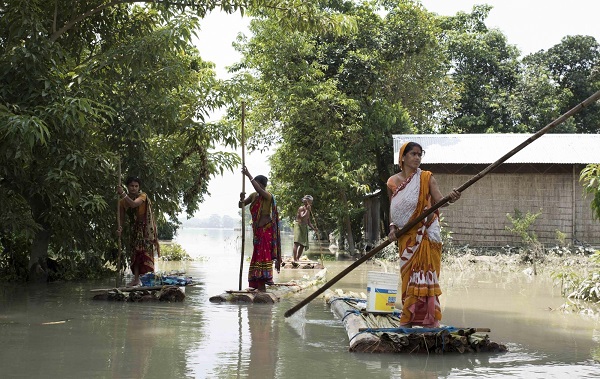Guwahati, (Samajweekly) The ongoing flood situation in Assam further worsened on Monday with 3.18 lakh people affected in 13 districts and one more person dying, officials said.
Assam State Disaster Management Authority (ASDMA) officials said that in the third wave of floods amid the Covid-19 crisis, around 13,500 hectares of crops in 390 villages under 13 districts have been inundated.
The officials said that one person was reported dead in Nagaon district while another remained missing in Dhemaji district, taking the total death toll to 119 in this year’s monsoon floods.
“The district administrations have set up 13 relief camps and a large number of people have taken shelter,” the officials said. The worst-affected districts are Dhemaji, Lakhimpur, Biswanath, Kamrup, Hojai, Nagaon, Majuli, Jorhat, Morigaon, Tinsukia, Dibrugarh, Sivasagar and West Karbi Anglong.
The officials said that around 74,000 domesticated animals were also affected due to the flood, which also damaged many road, bridges, embankments, government buildings and schools.
The swollen Brahmaputra was flowing above the danger level at Neamatighat in Jorhat and Sonitpur districts while two of its tributaries, Jia Bharali and Kopili crossed the danger mark in Sonitpur and Nagaon districts, respectively.
Like previous years, Assam, until early August, witnessed devastating floods that killed 119 people in 22 districts, while 26 others were killed in landslides since May 22.
With a respite in monsoon rains, the situation significantly improved in the first week of August even as 57 lakh people were affected in 5,378 villages in 30 of the state’s 33 districts.
Assam witnessed 12 per cent excess rainfall (actual 1,647.8 mm against normal 1,473.4 mm) in the four-month (June-September) monsoon period. In September so far, the state recorded 43 per cent excess rainfall (370.6 mm against normal 259.6 mm).
A six-member Central team led by Sandeep Poundrik, Joint Secretary (Mitigation), National Disaster Management Authority, had visited Assam last month to assess the damage caused by the floods, which also killed wild animals in various sanctuaries and national parks, including the world-famous Kaziranga National Park, where 18 rhinos and 135 wild animals died due to the deluge.









